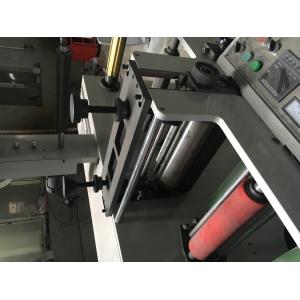

Add to Cart
Allfine Group-20 years experience Solution
1:Label production line- flexo print machine,die cutting
machine,slitting machine,inspection and rewinding machine
2:Flexible package line-water bottle label PVC,heat transfer Pet,
Opp, Pe etc rotogravure printer, dry laminator, PP PE film blowing
machine,bag making machine
3:Decal paper,wine and smoking package-Silk screen press machinery,
wicket dryer, uv dryer
4:Paper cup production line- flexo printer. die cutting machine,
paper cup making machine
1: Save material 2: Improve efficiency 3:Professional tranning 4: Factory built
Partner Manager-Jack Huang
Allfine Group
7color 320 two units(4+3) Label flexo fabric printer machine self-adhesive sticker/label to mould die cutter
flexo printing production line.pdf
| Model | Label flexo printing machine (printing speed 100m/min) | ||||
| Width | 320mm | 420mm | 520mm | ||
| Note: upgrade model will be with 2 servo motors and drives, PLC(Germany siemens), Touch screen(Taiwan Weinview), etc. The printing speed is 100m/min. |
Standard configuration 1. 1set of printing rollers 2. 1set of anilox roller 3. IR Dryer 4. One rotary die-cutting station 5. Unwinder tension controller (China brand) 6. Rewinder tension controller (China brand) 7. Web-guiding system: Simulation EPC |
| Technical Data | |||
| Model | 320 | 420 | 520 |
| Printing speed | 100m/min | 100m/min | 100m/min |
| Printing color | 4colours | 4colours | 4colours |
| Max. width of paper | 350mm | 450mm | 550mm |
| Max .printing width | 320mm | 420mm | 520mm |
| Max. unwinding diameter | 600mm | 600mm | 600mm |
| Max. rewinding diameter | 600mm | 600mm | 600mm |
| Printing length | 175-355mm | 175-355mm | 175-355mm |
| Precision of chromatography | ±0.1mm | ±0.1mm | ±0.1mm |
| Dimensions | 2m*1.0m*2.2m | 2m*1.1m*2.2m | 2m*1.2m*2.2m |
| Machine weight | About 2600kg | About 2800kg | About 3000kg |
LC-320Z automatic label die cutting machine
HD video link about LC- 350Z Medium Speed Die Cutting Machine (300
times per min, running at domestic customer's factory)
https://youtu.be/BwWWdGclTH8
Platemaking[3]
The first method of plate development uses light-sensitive polymer.
A film negative is placed over the plate, which is exposed to
ultra-violet light. The polymer hardens where light passes through
the film. The remaining polymer has the consistency of chewed gum.
It is washed away in a tank of either water or solvent. Brushes
scrub the plate to facilitate the "washout" process. The process
can differ depending on whether solid sheets of photopolymer or
liquid photopolymer are used, but the principle is still the same.
The plate to be washed out is fixed in the orbital washout unit on
a sticky base plate. The plate is washed out in a mixture of water
and 1% dishwasher soap, at a temperature of approximately 40 °C.
The unit is equipped with a dual membrane filter. With this the
environmental burdening is kept to an absolute minimum. The
membrane unit separates photopolymer from the washout water. After
addition of absorb gelatine for example, the photopolymer residue
can be disposed of as standard solid waste together with household
refuse. The recycled water is re-used without adding any
detergent.[4]
